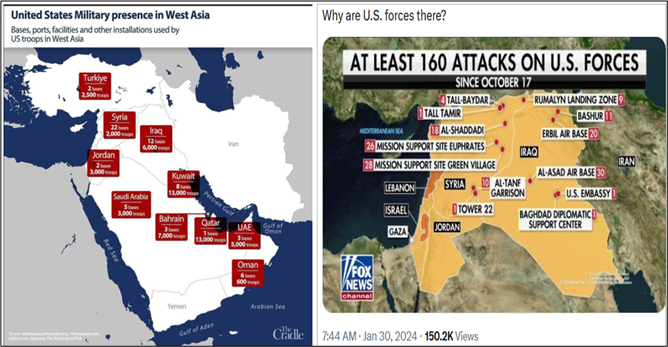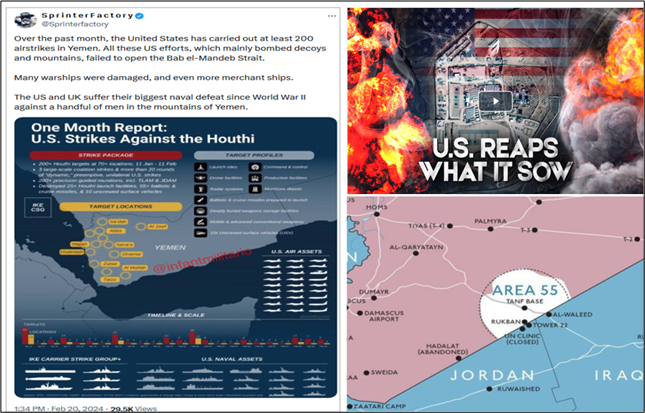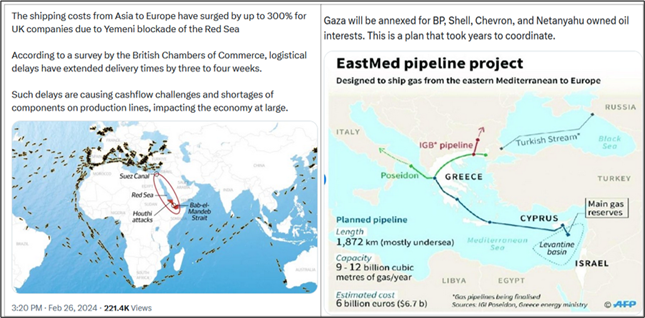Variety of wars in the Middle East
In political science and in academic research on international relations, a proxy war can be defined as an armed conflict fought between two belligerents, wherein one belligerent is a non-state actor (or sometimes a state actor) supported by an external third-party power. In the term proxy war, the non-state actor is the proxy, yet both belligerents in a proxy war can be considered proxies, if both are receiving foreign military aid from a third-party country.
Acting either as a nation-state government or as a conventional force, a proxy belligerent acts on behalf of a third-party state sponsor. A proxy war is characterized by a direct, long-term, geopolitical relationship between the third-party sponsor states and their client states and/or non-state clients.
During the Cold War, proxy warfare was motivated by fears that an armed conflict between the United States and the Soviet Union by conventional warfare would result in nuclear holocaust, which rendered the use of ideological proxies a safer way to conduct hostilities. The Soviet government found that supporting parties antagonistic to the US and other Western nations was a cost-effective way to combat NATO’s influence compared to direct military engagement. Besides, the proliferation of televised media and its impact on public perception encouraged the American practice of arming insurgent forces, such as the mujahideen during the Soviet–Afghan War. Today, use of proxies is more the rule than exception in international conflicts.
The undertaking of proxy wars by states, especially great powers, is inextricably linked with their wider geostrategic concerns, prompted in the main by interests, ideology and perceptions of risk. Modern-day proxy wars have become “effects-based operations” whereby a specific objective is desired without risking foreseen consequences and at an acceptable monetary cost, all of which is achieved without a state having to directly commit military forces of its own.
Since the end of the Cold War, great power-induced proxy wars have been accompanied by proxy wars driven by regional powers via the cross-border militia groups, witnessed especially in Africa. Another revealing trend is the increasingly multilateral nature of proxy war-fighting. The predominantly unilateral way in which the two Cold War superpowers provided their chosen proxies with arms, training and money has evolved in the early twenty-first century into coalition proxy warfare.
That is not to say that single-state proxy strategies are obsolete but merely that there has been a trend towards collective proxy strategies. This has taken the form of either deliberate proxy coalitions, such as the NATO block collectively operating for anti-Qaddafi forces during the 2011 Libya uprising or of informal alliances that stem from mutual selection of the same proxy, such as Syria and Iran through their support for Hizbollah in its battle against the Israeli state.
Characteristics of the Middle East wars – numerous wars at the same time
Considering the entire MENA region, Middle East and North Africa, a nearly-unbelievable variety of different conflicts and disputes are going on at the same time and having taken forms of wide range, from direct two-party war to complicated, multilayered proxy wars.
Hardly anywhere in the world, one can find so many different jihadist groups as here and making things more challenging to outside analyst, the nature and character of these groups and their engagements are very dynamic changing in time and space. Therefore, only a cursory review is stated here.
The US, which has been a major player in the region since WWII, has traditionally three key local partners, Israel, Saudi Arabia and Turkey, from which as a proxy, the US has utilized mainly Israel and to some extent Turkey. In last ten years or so, also the NATO and Kurds have been US proxies here.
As the old colonial patron, the UK still has some position and interests in the area. Turkey has its own war against Kurds and utilizes numerous local militias as proxies.
Iran, who is a major regional power in MENA, has used its power via Syria, Palestine, Hamas, Hizbollah, Yemen Huthis and tens of local jihadists and militias.
ISIS is forming its own chapter throughout the region, its origin and supporters seem to hide behind the scenes, but some evidence connects it with CIA secret operations.
Russia has “inherited” the former Soviet contacts but has developed some prominent new ones like close relations with Iran, which is also China’s key partner in the Middle East. Other Russia’s partners can be found in Syria, Iraq, Libya, Sudan, Egypt and Saudi Arabia.
Middle East Burning

Tensions Set Middle East Ablaze
South Front March 27, 2024
Middle East On Brink Of Total War
South Front April 3, 2024
The tensions created by the US-backed Israeli war on the Palestinian Gaza Strip continue to generate tensions all over the Middle East.
In Yemen, the Houthis (Ansar Allah) escalated attacks against military and commercial vessels affiliated with Israel, the US and the UK in the Red Sea and the Gulf of Aden. The group also said that they had attacked US military ships in the Red Sea as well as the southernmost Israeli city Eilat.
Meanwhile in Lebanon, clashes between Hezbollah and the Israeli military over the war in Gaza continue. Israel escalated by bombing the northeastern Lebanese regions, a known stronghold of Hezbollah. The Israeli military escalated airstrikes on the group’s heartland, southern Lebanon. Hezbollah responded by firing dozens of rockets at the northern Israeli settlement of Kiryat Shemona, killing Israelis and causing significant damage.
In Syria, tensions have been also mounting, a series of airstrikes hit the government-held part of the eastern governorate of Deir Ezzor. Syrian state-media said that the airstrikes claimed the lives of military personnel and civilians. Syrian military officials blamed the airstrikes on the US.
The Biden administration operates as if attempting to set the Middle East ablaze, which seems to be similar way, how Washington has been using Ukraine to destabilize Eastern Europe for the last two years. The Middle East is inching closer towards total war as a result of Israel’s ongoing war on the Gaza Strip and its repeated strikes against Iran, Syria and Lebanon.
The most serious of provocations was on April 1, when an Israeli airstrike destroyed the Iranian consulate building adjacent to the Iranian embassy in the Syrian capital, Damascus. The airstrike killed 13 people. The victims included a senior Quds Force commander of the Islamic Revolutionary Guard Corps (IRGC), Brigadier General Mohammad Reza Zahedi, and his deputy Brigadier General Mohammad Hadi Haji Rahimi as well as five Iranian officials, Hossein Aman Elahi, Sayid Mehdi Jalalati, Ali Agha Babaei, Sayid Ali Salehi Roozbahani and Mohsen Sedaghat.
Four other victims were Syrian nationals. Syria’s Foreign Minister Faisal Mekdad condemned the strike, calling it a “terrorist attack” which had killed innocents. Meanwhile, Iran’s Supreme Leader Ali Khamenei vowed a harsh response to the attack.
The attack was also condemned by Saudi Arabia, Egypt, the United Arab Emirates, Qatar, Kuwait, Jordan, Iraq, Oman, Pakistan and Turkey as well as to both China and Russia. In addition, Russia, who has been growing frustrated by Israel’s repeated attacks on Syria, requested a meeting with the UN Security Council regarding the strike on April 2.
In early April, Iran experienced a new wave of Western-backed terrorist attacks in Baluchistan – the area in southeast Iran that borders Pakistan and Afghanistan. US intelligence has had ties to Baluchis for at least 50 years, if not more. The latest attacks come within two days of Israel’s bombing of Iran’s Consulate in Damascus Syria.
Overall, Israel’s recent actions from Gaza to Syria have caused serious tensions in the Middle East. Iran and its allies in the so-called “Axis of Resistance” will certainly respond to the Israeli strikes, especially the deadly attack on the Iranian embassy in Damascus. This could lead to a full-blown military confrontation in the region.
The world has indeed taken another step towards WW3. If there is a large-scale military conflict between Iran and Israel, regardless of which side takes the initiative, the United States and Russia will be involved.
Iran has the ability to eliminate a large number of Israeli troops in a conventional war and the United States will not sit idly by in this case. Russia will be very pleased that Iran could start a second front in the Middle East. In order to encourage Iran to do so, it will provide nuclear protection to Iran when necessary. The model of the WW3 has been completed, with Russia+Iran+Shia alliance VS the United States+Israel+part of Europe. China is still waiting like the US in WW2.
While Iran’s direct strike on Israel may be possible, my estimate is that Iran will work with Hezbollah to deliver a major blow to an Israeli military unit or outpost in Israel. Iran also may give Shia groups in Iraq and Syria the green light to hit Israeli interests in Kurdistan. Iranian leaders are playing a much smarter game now having Russia and China in their camp.
Military situation in Palestine-Israel conflict, on April 8, 2024, map update

Falling position of the US
The United States has launched strikes against Iran’s allies in Iraq, Syria and Yemen, further escalating tensions in the Middle East, which began after the outbreak of the Israeli war on the Gaza Strip. Despite the scale of the attack, Iranian-backed forces were not deterred.
US actions were not limited to Iraq and Syria. On 3 February, the US and the UK conducted strikes against 36 sites of the Houthis (Ansar Allah) in Yemen, which included underground facilities, drone storage and operation sites, missile systems, radars and helicopters in 13 different locations.
Recent US attacks on Iraq, Syria and Yemen have not only failed to deter Iran and its allies but also made the situation in the Middle East far more dangerous. The attacks showed the length Washington is willing to go to in order to support the Israeli war on Gaza.

The Yemen Houthis (the Ansar Allah movement) have launched a lot of missile and drone attacks on the US and other countries’ Navy ships as well as civil and commercial ships. Numerous local and regional jihadist groups have launched attacks on US forces and bases located in the region.
The drone strike against Tower-22, a US troop base in northeastern Jordan, caught the US Army troops asleep, in late January 2024.
US policy in the Middle East can no longer be described as an attempt to stop the Israel-Gaza conflict from triggering a bigger regional war. That hope died weeks ago. The critical task now for President Joe Biden is to prevent that region-wide war from tipping out of control.
Military and political tensions in the Middle East around the Palestinian-Israeli conflict are gaining new momentum with a bias towards the expansion and internationalization of the conflict – from local to regional.
In addition to the epicentre of the military conflict between Hamas and Israel in the Gaza Strip, combat and sabotage-terrorist actions of local militias have spread to other territories and parts of the Middle East region (in particular, Lebanon, Iraq, Syria, Yemen, Iran, Pakistan, the waters of the Red Sea and the Gulf of Aden). Tel Aviv and Washington naturally link the combat activity of the same Yemeni Houthis, Lebanese Hezbollah, and Shiite groups in Syria and Iraq to Tehran, with the IRGC playing a coordinating and guiding role.

U.S. Reaps What It Sow In Middle East
South Front, February 1, 2024
Escalating conflict in the wider framework
Latest turbulence has caused a lot of troubles in the maritime traffic. Moreover, considering any Middle East affair, oil and gas are always in the key position behind.

The Red Sea conflict is intensifying as is the impact on commercial shipping and the global economy, according to shipping news reports. One might think that common sense would prevail here to solve the conflict diplomatically and quickly. If a ceasefire was called in Gaza to stop the devastating crisis, then that would end the restrictions imposed on shipping by Yemen, because Yemeni leaders have unequivocally said so.
The United States has the power to end the military conflict but the Biden administration has refused to exert its control over the Israeli military. Moreover, Washington has opted to escalate the military operation in the Red Sea by launching waves of air strikes since mid-January on Yemen. The Yemenis have in turn defiantly warned that their operations to interdict shipping will continue until the military siege on Gaza has ended. Biden even admits that the military action to deter the Yemenis is limited in achieving its supposed objectives.
So, why continue to aggravate the situation and escalate potential conflict across the region? Bombing Yemen does not work but it is also inflaming violence across the Middle East and risking a head-on confrontation with Iran, which is allied with the Yemenis.
A big incentive for the Biden administration seems to be to blow up the region in a way to conceal how disastrous the defeat in Gaza is for the Americans. But there may be more to it. Another incentive for taking a militarized response to the Red Sea crisis is the strategic gain that this gives the United States with regard to Europe and China.
The Red Sea shipping restrictions are hitting the European and Chinese trade most acutely. American economic interests are relatively unaffected. It is estimated that about 60 percent of China’s exports to Europe are shipped through the Red Sea, according to the Washington DC-based Middle East Institute. Put another way, Eurostat figures indicate that 20 percent of all EU imports come from Asia via the Red Sea. Inevitably, the longer the insecurity and hostilities persist in the Red Sea, the worse will be damage to Europe-China trade and their economies.
The Europeans seem oblivious to the damage that the United States’ policy is inflicting on their economies. The Europeans have gone along with Washington’s militarized aggression against Yemen. It is a long-term goal for Washington to prevent European trade and political relations with China. China has become the European Union’s top trading partner, surpassing the US in that historic role.
The Red Sea crisis is thus a handy opportunity for the US to kill two birds with one stone. By ramping up the shipping problems through militarizing the conditions, the US can weaken the economies of Europe and China while also sticking a very big wedge between the two. The US consolidates its hegemonic control over the weaker European allies while damaging China’s economic power.
There is a close analogy here to the Ukraine crisis. Washington has pursued hostilities with Russia as a way to undermine European-Russian trade and their wider cultural and political relations. Washington calculates that such antagonism will bolster its hegemonic ambitions. The ideologically slavish European leaders have gone along with that policy even though it has resulted in an economic and security disaster for Europe.
The European leaders are either too stupid or too brainwashed to assess what is going on and how they are being manipulated by Washington for its selfish strategic interests. If the European regimes had any independence or integrity, they would not have gone down the path of conflict with Russia in Ukraine and what’s more, they don’t seem to realize or even care.
Likewise, the same European fate of shooting themselves in the foot is occurring over the Middle East crisis. The Europeans are backing the US escalating in Gaza, Red Sea and nearby. Rather than seeking to resolve the conflict diplomatically, the Europeans are making it worse and damaging their own international standing and strategic interests in this way. No wonder the Americans ultimately treat their European vassals with contempt, because they are utterly spineless and clueless.
Closing words
Upping the ante, a US official has told Al Jazeera, April 10, that the Pentagon could intervene militarily, if there is an Iranian attack launched against Israel. The US source said, “We do not rule out launching joint retaliatory strikes with Israel if it is attacked by Iran or its agents.”
Yesterday, Israeli officials threatened that Iranian nuclear sites could be targeted, in one of the biggest strike threats to date. The region is on edge awaiting an “imminent” response by Iran following the April 1st deadly attack on Iran’s embassy in Damascus. US intelligence has said it believes a revenge attack from Tehran is coming soon. The US and its allies believe major missile or drone strikes by Iran or its proxies against military and government targets in Israel are imminent, in what would mark a significant widening of the six-month-old conflict.
It is seen as more a matter of when, not if, one of the people said, based on assessments from US and Israeli intelligence. US and Western intelligence indicate an attack from Iran and its proxies may not necessarily come from Israel’s north, where Tehran’s ally Hezbollah in Lebanon is located. Israeli officials also publicly threatened Iran that if it hits Israeli soil, Israel will hit Iranian soil.
Earlier on Wednesday Iran’s Supreme Leader Ayatollah Ali Khamenei repeated a vow to retaliate against Israel for the Damascus strike, which he said was tantamount to an attack on Iranian territory.
On April 11, Israeli media sources have claimed that Iran is poised to launch a major attack on Israel but that the strikes were postponed “at the last minute”. Israeli news website Ynet reported Thursday that “Tehran decided to either delay the strike or change the nature of its response to Israel’s attack on its consulate in Damascus”.


